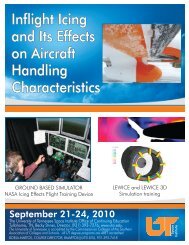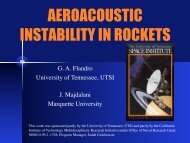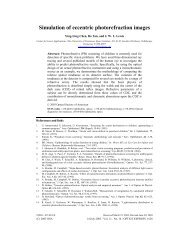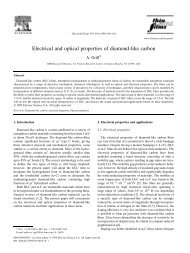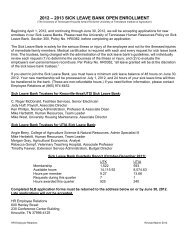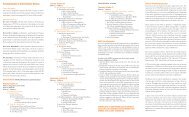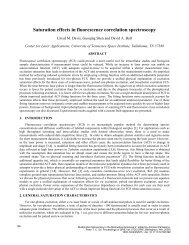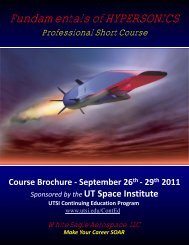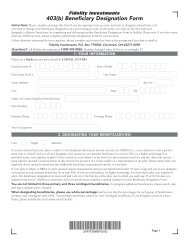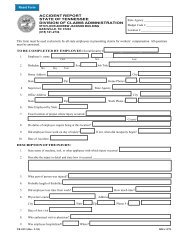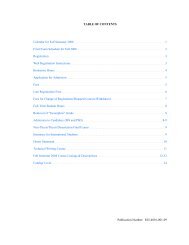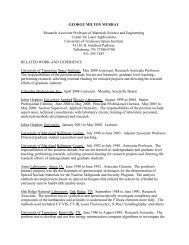Read more
Read more
Read more
You also want an ePaper? Increase the reach of your titles
YUMPU automatically turns print PDFs into web optimized ePapers that Google loves.
National Aeronautics and Space Administration<br />
MSFC SCIENCE & MISSION SYSTEMS<br />
SCIENCE & MISSION SYSTEMS<br />
MAPIR: An Airborne Polarimetric Imaging Radiometer<br />
in Support of Hydrologic Satellite Observations<br />
C. Laymon 1 , M. Al-Hamdan 2 , W. Crosson 2 , A. Limaye 2 , J. McCracken 1 ,<br />
P. Meyer 1 , J. Richeson 3 , W. Sims 1 , K. Srinivasan 2 , K. Varnevas 1<br />
1<br />
George C. Marshall Space Flight Center, NASA, Huntsville, Alabama<br />
2<br />
Universities Space Research Association, Huntsville, Alabama<br />
3<br />
Integrated Concepts & Research Corporation, Huntsville, Alabama<br />
IEEE Geoscience and Remote Sensing Symposium, July 26-30, 2010, Honolulu, Hawaii 1
Science Motivation<br />
MSFC SCIENCE & MISSION SYSTEMS<br />
Earth Science<br />
Vision 2030<br />
March 2004<br />
NASA Science Plan<br />
2007<br />
National Research Council<br />
Earth Science and<br />
Applications from Space<br />
January 2007<br />
NASA Earth Science Technology Office<br />
GPM<br />
Global Precipitation Mission<br />
2013-<br />
ICESat-2<br />
2015-<br />
SMAP<br />
Soil Moisture Active Passive<br />
2014-<br />
DESDynI<br />
Deformation, Ecosystem<br />
Structure, Dynamics of Ice<br />
2017-<br />
SWOT<br />
Surface Water<br />
Ocean Topography<br />
2020-<br />
Reports contain common theme of need for<br />
measurements of precipitation, soil moisture,<br />
and sea ice and provide measurement goals.<br />
Shortage of available airborne simulators and<br />
instruments to produce data for algorithm development,<br />
validation, and for applied science activities.<br />
IEEE Geoscience and Remote Sensing Symposium, July 26-30, 2010, Honolulu, Hawaii 2
Science Applications<br />
MSFC SCIENCE & MISSION SYSTEMS<br />
Weather<br />
Forecasting<br />
Flood Water<br />
Monitoring<br />
Hydrologic<br />
Modeling<br />
L-band<br />
Supported NASA Missions:<br />
SMAP<br />
DESDynI<br />
HyspIRI<br />
NPOESS<br />
GPM<br />
Human Health &<br />
Air Quality<br />
Precipitation<br />
Validation<br />
Drought<br />
Detection<br />
Instrument<br />
Performance<br />
Capabilities<br />
Landslides<br />
National Defense<br />
Applications<br />
Biomass &<br />
Ecosystem Health<br />
Irrigation Scheduling<br />
Agricultural Productivity<br />
L-band RFI<br />
Surveillance<br />
IEEE Geoscience and Remote Sensing Symposium, July 26-30, 2010, Honolulu, Hawaii 3
System Architecture<br />
MSFC SCIENCE & MISSION SYSTEMS<br />
IEEE Geoscience and Remote Sensing Symposium, July 26-30, 2010, Honolulu, Hawaii 4
Phased Array Antenna<br />
MSFC SCIENCE & MISSION SYSTEMS<br />
Frequency<br />
Antenna Type<br />
Array<br />
Dimensions<br />
Weight<br />
Beamwidth<br />
Polarizations<br />
Beams<br />
Scan Type<br />
Control<br />
Electronics<br />
Calibration<br />
L- band (2 passbands)<br />
Real aperture planar phased array<br />
81 element (9x9) electronic beam steering<br />
102 x 102 x 18 cm<br />
57 kg<br />
15 deg (3dB at nadir)<br />
Horizontal, Vertical<br />
2 simultaneous acquisition<br />
Push-broom, Conical, Staring at any angle<br />
In-flight reprogrammable scan mode<br />
Programmable Integrated circuit (PIC)<br />
Emitted Gaussian noise source,<br />
50 ohm termination<br />
Behind the antenna<br />
elements are the<br />
electronic control<br />
components.<br />
The front side comprises<br />
passive antenna<br />
elements.<br />
Each antenna<br />
element has a circuit<br />
board that steers<br />
the beam and<br />
switches RF<br />
polarization.<br />
IEEE Geoscience and Remote Sensing Symposium, July 26-30, 2010, Honolulu, Hawaii 5
Receivers<br />
MSFC SCIENCE & MISSION SYSTEMS<br />
Type<br />
Hach<br />
No. Channels 4<br />
Array<br />
81 element (9x9) electronic beam steering<br />
Four receivers acquire data at<br />
two narrow bands and two wide<br />
bands simultaneously.<br />
shown<br />
Narrow<br />
Wide<br />
No. Receivers 2 2<br />
Antenna Inputs 2 ea. 2 ea.<br />
Passbands 1401-1425 MHz 1350-1450 MHz<br />
Integration Time 10 ms (min.) 10 ms (min.)<br />
Dimensions 7.6 x 7.6 x 7.6 cm 8.9 x 8.9 x 5 cm<br />
Internal Cal. Loads<br />
Warm: 300 K<br />
Cold: 210 K<br />
Warm: 300 K<br />
Cold: 210 K<br />
Down Convert Freq. 8-32 MHz 10-110 MHz<br />
All four receivers are integrated into<br />
a common enclosure with required<br />
splitters, filters and amplifiers.<br />
The wide band receivers developed inhouse<br />
observe a wider spectrum for<br />
possible RFI that may effect observations.<br />
Theses radiometers are a byproduct of a<br />
IEEE Geoscience and Remote Sensing Symposium, July 26-30, 2010, Honolulu, Hawaii Phase I and Phase II SBIR<br />
6
Correlator & Digital Back End<br />
MSFC SCIENCE & MISSION SYSTEMS<br />
Dimensions<br />
Filters<br />
Subchannel<br />
Bandwidth<br />
Clock<br />
Digitizer<br />
Correlator<br />
RFI Processing<br />
Control<br />
Storage<br />
48 cm x 69 cm x 22 cm<br />
16 subbands for each channel<br />
1.625 MHz (narrowband receiver)<br />
7.8125 MHz (wideband receiver)<br />
125 MHz oscillator<br />
12 bit ADC; internal processing to 7 bit<br />
Nallatech BenADC-V4 with Xilinx FPGA<br />
ADD method: Computes I & Q moments<br />
RTD PC/104-Plus stack<br />
11 Mb packets<br />
Control Computer:<br />
RTD PC/104-Plus Stack<br />
Correlator Module:<br />
Nallatech BenADC-V4<br />
firmware with Xilinx Spartan<br />
FPGA<br />
Developed by Univ. of Michigan,<br />
Space Physics Research Lab<br />
IEEE Geoscience and Remote Sensing Symposium, July 26-30, 2010, Honolulu, Hawaii 7
Command and Control<br />
MSFC SCIENCE & MISSION SYSTEMS<br />
DBE Clock Speed<br />
Antenna Switch Time<br />
No. Beams & Scan Angles<br />
Platform Altitude & Speed<br />
Minimum Allowable<br />
Integration Time<br />
Maximum Allowable<br />
Integration Time<br />
Operational<br />
Integration<br />
Time<br />
Key<br />
IEEE Geoscience and Remote Sensing Symposium, July 26-30, 2010, Honolulu, Hawaii 8
Calibration Method<br />
MSFC SCIENCE & MISSION SYSTEMS<br />
Motivation: In-flight real-time continuous calibration<br />
Features:<br />
• Two diode calibration<br />
• End-to-end calibration for a phased array system<br />
• Calibrate every scan angle in real time<br />
• Utilize mutual coupling between antenna elements<br />
as a calibration source<br />
Implementation:<br />
• Radiate a noise source from the center element of<br />
the array<br />
• Radiated diode (ENR = 40 dB) and an injected<br />
noise source (~300 K)<br />
IEEE Geoscience and Remote Sensing Symposium, July 26-30, 2010, Honolulu, Hawaii 9
Calibration<br />
MSFC SCIENCE & MISSION SYSTEMS<br />
Receiver Noise Temperature<br />
Pre-detection Bandwidth<br />
Antenna Noise Temperature<br />
Total Dwell Time<br />
Radiometer Warm Load (1)<br />
Radiometer Cold Load (1)<br />
Antenna Injected Load (2)<br />
Antenna Radiated Diode (2)<br />
400 K<br />
24 MHz<br />
300 K<br />
1 sec<br />
300K<br />
210K<br />
300K<br />
300K<br />
Antenna Gain = 3<br />
(1)<br />
Two radiometer loads – Goodberlet et al, 2006<br />
(2)<br />
Two Diode method<br />
IEEE Geoscience and Remote Sensing Symposium, July 26-30, 2010, Honolulu, Hawaii 10
Performance Evaluation<br />
MSFC SCIENCE & MISSION SYSTEMS<br />
• TB time series, 10 azimuth angles<br />
• shows system stability relative to range<br />
of Earth observations<br />
• RMSE at 10 msec = 2.5 K<br />
• no system-generated RFI observed<br />
Experimental Set-up<br />
• NASA EMI chamber<br />
• Antenna on table looking at ceiling<br />
• Scanning forward half only (0-160° azimuth)<br />
in 20° increments at 40° look angle<br />
• Control system in adjoining room<br />
0<br />
10 20 40 60<br />
80 100 120 140 160<br />
Observations sorted by angle along<br />
with diode measurements<br />
0<br />
10 20 40 60<br />
80 100 120 140 160<br />
• TB observations sorted by angle<br />
• larger variability at 60°, and 160° can be<br />
attributed to lack of separation of scene<br />
obs from either or both calibration<br />
diodes<br />
IEEE Geoscience and Remote Sensing Symposium, July 26-30, 2010, Honolulu, Hawaii 11
Performance Evaluation<br />
MSFC SCIENCE & MISSION SYSTEMS<br />
Evaluation:<br />
Results:<br />
Beam patterns<br />
Symmetric<br />
3 dB nadir beamwidth 15 degrees<br />
Side lobe characterization 1 st side lobe: -20 dB<br />
Functionality of scan modes Functionality of all modes confirmed<br />
Cross polarization isolation 30 dB<br />
IEEE Geoscience and Remote Sensing Symposium, July 26-30, 2010, Honolulu, Hawaii 12
Aircraft Integration<br />
MSFC SCIENCE & MISSION SYSTEMS<br />
NASA P3-B Orion<br />
UTSI Piper Navajo, PA-31<br />
Forklift raises antenna<br />
into bomb bay<br />
Adapter box provides<br />
interface between<br />
antenna and aircraft<br />
Structural interface<br />
for antenna inside<br />
bomb bay<br />
Single GN2 tank installed<br />
in left wing locker<br />
Belly pod fairings fabricated<br />
in-house at UTSI<br />
IEEE Geoscience and Remote Sensing Symposium, July 26-30, 2010, Honolulu, Hawaii 13
Airborne Platform Configuration<br />
MSFC SCIENCE & MISSION SYSTEMS<br />
Piper Navajo PA-31 (N11UT)<br />
Instrumentation<br />
• MAPIR<br />
L-band brightness temperature<br />
• Infrared Pyrometer<br />
Surface temperature<br />
• Laser Altimeter<br />
Precise platform altitude<br />
Vegetation canopy height<br />
• PAR (Up, Down)<br />
Photosynthetically active radiation<br />
• Total Solar Radiation Pyrometer<br />
Downwelling solar radiation<br />
MAPIR<br />
Nadir Digital Video<br />
Nitrogen Purge Tank<br />
Laser Altimeter (Down)<br />
GPS Antenna<br />
PAR (Down)<br />
Forward Digital Video<br />
PAR (Up)<br />
SP Lite (Up)<br />
IR Pyrometer (Down)<br />
Nadir TIR<br />
Supporting Equipment<br />
• GPS Antenna<br />
Platform position and attitude<br />
• Nitrogen Source Tank with Electronic Controller<br />
Humidity control inside MAPIR antenna enclosure<br />
• Forward and Nadir Digital Video<br />
• Data Acquisition System<br />
GPS Antenna<br />
Laser Altimeter<br />
IR Pyrometer<br />
Nadir TIR<br />
PAR (Up)<br />
Forward Digital<br />
Video<br />
PAR (Down)<br />
IEEE Geoscience and Remote Sensing Symposium, July 26-30, 2010, Honolulu, Hawaii 14<br />
MAPIR
Flight Mission Profile<br />
MSFC SCIENCE & MISSION SYSTEMS<br />
Study area in central Tennessee<br />
Typical Climate<br />
Reference Network<br />
station configuration<br />
Crossville<br />
CHESS<br />
Normandy<br />
Lake<br />
Watts Bar<br />
Reservoir<br />
CHESS tower at Oak<br />
Ridge National Lab<br />
Normandy Lake used for<br />
water calibration<br />
Tullahoma, TN<br />
Four flight lines intersect over<br />
instrument station<br />
IEEE Geoscience and Remote Sensing Symposium, July 26-30, 2010, Honolulu, Hawaii 15
Demonstrated Performance<br />
MSFC SCIENCE & MISSION SYSTEMS<br />
Vertical polarization; single beam conical<br />
scan at 40° look angle; 4600 ft.AGL; raw<br />
observed TB data, not gridded<br />
236<br />
265<br />
200<br />
Vertical polarization;<br />
Nadir at 3540 ft. msl<br />
283 270 260<br />
220<br />
Landscape is gently rolling<br />
with a mix of woodland,<br />
pasture and cropland<br />
Watts Bar<br />
Reservoir<br />
CRN Station<br />
at Crossville<br />
Vertical polarization; conical<br />
scan mode at 5500 ft. msl<br />
IEEE Geoscience and Remote Sensing Symposium, July 26-30, 2010, Honolulu, Hawaii 16
RF Interference Characterization<br />
MSFC SCIENCE & MISSION SYSTEMS<br />
No. of Subband<br />
with RFI Detected<br />
1<br />
2<br />
3<br />
4<br />
5<br />
6<br />
7<br />
8<br />
9<br />
10<br />
11<br />
12<br />
13<br />
14<br />
15<br />
16<br />
%<br />
625 m AGL<br />
625 m AGL<br />
Horizontal Polarization<br />
%<br />
533 m AGL<br />
Vertical Polarization<br />
%<br />
442 m AGL<br />
Subband<br />
IEEE Geoscience and Remote Sensing Symposium, July 26-30, 2010, Honolulu, Hawaii 17
Conclusions & Future Work<br />
MSFC SCIENCE & MISSION SYSTEMS<br />
Conclusions<br />
• Results indicate successful performance of beam forming radiometer<br />
• Successful implementation of real-time calibration with emitted and<br />
injected Gaussian noise<br />
• Opportunities for improvement<br />
Future Work<br />
• Improve calibration method<br />
• Implement angle (phase) specific calibration<br />
• Refine gridded product production<br />
• Conduct additional performance tests<br />
• In situ observations<br />
• Mapping<br />
• Instrument intercomparisons<br />
• Conduct <strong>more</strong> RFI analysis<br />
FR2.L07.2 (10:45, Nautilus) Phased array radiometer calibration using a radiated noise source;<br />
Srinivasan, Limaye, Laymon, and Meyer<br />
IEEE Geoscience and Remote Sensing Symposium, July 26-30, 2010, Honolulu, Hawaii 18



